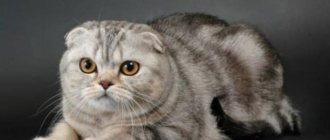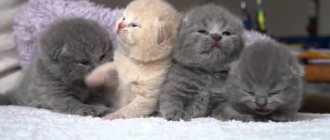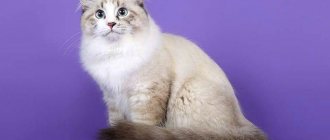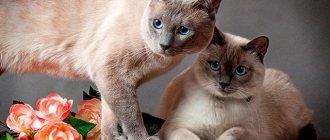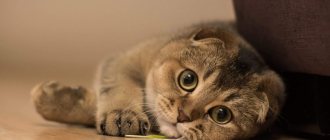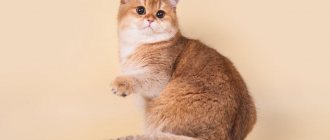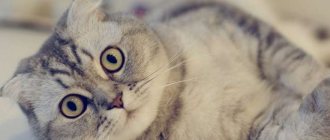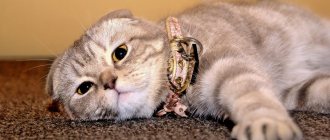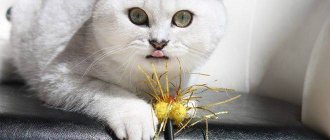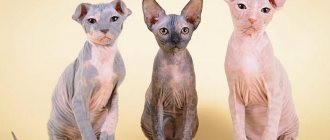The Scottish Fold cat is one of the most popular in the world. She won millions of hearts with her resemblance to a plush toy. The highlight of this breed is the special shape of the ears, which are slightly tilted forward and curved down. Behind the pretty appearance lies a noble and vulnerable character. Before you decide to get a Scottish Fold, you should get to know her better and study the recommendations for keeping, feeding and breeding a cat.
Content
- History of the origin of the breed
- Description of the breed Colors
- Interaction with children
- Bathing
History of the origin of the breed
In 1961, a fold-eared cat was born on the estate of a Scottish farmer, who was named Susie. When she grew up, she gave birth to a litter. Several kittens have inherited the characteristic ear shape from their mother. One of them was later offered to British cat breeder Mary Ross. She chose a girl and named her Snoopy.
The next year, the woman received the first litter from her pet. She especially liked a cat with a white color and drooping ears. Mary decided to keep him and, when he grew up, crossed him with her pet British Shorthair. At the same time, the breeder bred his mother Snoopy to a blue Briton. The kittens that were born later became the progenitors of the new Scottish Fold breed.
The dominant Fd gene is responsible for lop ears. If both parents are its carriers, then the kittens born from such a pair develop various pathologies. Most often these are problems with the musculoskeletal system. For this reason, today it is allowed to breed Scottish Folds only with straight-eared Scottish Straights.
The breed is registered by felinological organizations CFA, TICA and WCF. However, until now it remains unrecognized in FIFE, but this fact does not prevent the breed from gaining more and more admirers.
Types of coloring
Thanks to the import of representatives of this breed from abroad, today there are a large number of different shades and colors of wool. The following colors are often found:
Solid color - the color of the cat's coat has the same tone.
Tortoiseshell color is a combination of rich cream, black or red tones.
“Chinchilla” - only part of the fur is colored, and the rest is white.
Tabby color - different patterns on the coat (brindle, marbled, striped).
Bicolor color - white chin, chest, paws, neck, legs. The main thing is that half of the body is white.
Color point - parts of the body such as the muzzle, ears, tail, and paws have a light or contrasting tone.
Smoky color – characterizes the silvery undercoat. Contrast with guard coat.
As for the color of the eyes, the Scots often have orange or copper color. But, as exceptions, color-point cats have blue eyes, while chinchillas have golden eyes.
Description of the breed
Scottish Folds are medium-sized animals. The height at the withers of an adult cat is 27–30 cm, weight – 4–5.5 kg. The appearance of the cat must exactly correspond to the description of the breed:
- The head is round in shape with large cheeks and a strong chin.
- The nose is small, but quite wide with a neat nose.
- The eyes are large and round, the look is expressive. The color of the iris must match the color.
- Ears are small or medium in size. The tips are folded and pressed to the head. The shells themselves are set wide, but do not protrude beyond the contours of the cheeks.
- The neck is short and wide.
- The body is downed and stocky. The shoulder girdle and chest are well developed.
- The limbs are of medium length with small rounded paws.
- The tail near the base is quite wide, gradually tapering towards the end, mobile, of medium length.
- The coat is short with a very thick undercoat, soft and pleasant to the touch. The hairs do not adhere to the body.
According to the description of the breed, there are 3 types of lop ears - single, double and triple. In the first case, only the tips of the cat's ears are bent. In the second, the entire shell is folded, but there is still a small gap between the head and ears. Triple fold means that the shells fit tightly to the head.
Colors
The breed standard allows for a variety of coat colors - plain, bicolor, tabby, color-point, tortoiseshell, chinchilla, smoky, as well as ticked and shaded.
When evaluating animals at an exhibition, commission members strictly ensure that the color matches the color of the nose, paw pads and the shade of the iris. Examples in the table below. Table - Scottish Fold breed standard
| Color | Eye color | Nose and pads |
| White | Golden, blue | Pink |
| Black | Golden | Black or dark gray |
| Smoky | Golden yellow | Black or dark gray |
Colors
There are no strict requirements for color. But at competitions special attention is always paid to harmony, namely: does the color of the eyes and nose match the main color or not? If yes, the animal will receive additional points. Blue or golden eyes with a pink nose and white coat are valued, as well as golden eyes and black paw pads with a jet-black coat.
In the photo there are cats of the Scottish Fold breed (Scottish Fold) of popular colors
Character and habits
Scottish Folds are cats that were bred exclusively as a breed for home keeping. Its representatives have never lived on the street, so they tend to become very attached to their owner and home. Even rearranging furniture can cause stress for a Scottish Fold, let alone moving to a new place of residence.
Adult Scottish Folds have a phlegmatic character. They display a sedateness and aristocracy, which was probably inherited from British cats. They behave calmly and balanced in any situation. Kittens are usually playful and inquisitive, but they can hardly be called hyperactive.
Sensitive and vulnerable by nature, Scottish Folds need affection more than representatives of other breeds. Begging for the next portion of affection, the pet literally follows on the heels of the object of its adoration. Seizing the moment when the owner is free, the fold-eared cat will immediately try to capture his attention and sit next to him.
Scottish Fold cats do not tolerate separation from their owner well. For them, this is a real test, which can lead to loss of appetite or even illness due to stress.
Despite their strong affection for humans, Scottish Folds do not like to be picked up or cuddled. They prefer to bask in the arms of their owner, lying next to them on the bed or sitting in a chair. Scottish Folds are not very talkative; moreover, they have a quiet voice, reminiscent of a squeak. Some owners of Scottish Folds have never heard their pets meow at all.
Interaction with children
Scottish Fold cats are often bred specifically for children. An affectionate and calm pet can become a child’s best friend, provided that the child respects his personal space. Although Scottish Folds are not happy with annoying hugs, they do not allow themselves to be aggressive towards children. There are practically no cases when a cat is ready to use its claws and teeth; this is rather an exception to the rule. A lop-eared pet will prefer to retire to a safe place for a while rather than offend the baby.
How do Scottish Folds get along with other animals?
Scottish Folds feel comfortable in the company of a dog, especially if the pets grew up together. Friendship with cats of other breeds is also possible, but you need to keep in mind that Scottish Folds are jealous. If there are several cats living at home, then each of them should receive care and attention equally. The one thing Scotswomen cannot get along with is parrots and small rodents. Although cats of this breed seem slow, they have a well-developed hunting instinct.
Upbringing
Scottish Folds are smart, so they easily learn to order. They quickly remember how to use the tray and scratching post, and learn the rules of behavior in the house. The main condition for successful parenting is patience and perseverance. Rough treatment can only lead to the loss of the pet's trust. It is better to use reward methods - praise and treat the cat with something tasty when it shows obedience.
Interesting Facts
The long-haired straight-eared cat got its name from the mountainous terrain in Scotland, where the breed originated. The word highland translated from English means “highlands”.
Other interesting facts about Highland Straights:
- These cats have a poorly developed vestibular apparatus. When falling from a height, they do not always land on their feet. Scottish Longhairs are afraid when they are picked up and never climb to heights themselves.
- The Highland Straight gene for long hair was inherited from representatives of the Persian breed.
- Both straight-eared and fold-eared longhaired Scots are used to work with children with special needs. They are present in school classes in some European countries.
Recommendations for the maintenance and care of the Scottish Fold
Bathing
Since Scottish Fold cats have short fur that does not tangle, it is enough to brush it once every 3 days. When shedding begins, the procedure is carried out daily so that the pet does not swallow hair - representatives of this breed are clean and love to lick themselves. It is recommended to bathe the animal once a month using cat shampoo. Human is not suitable - it can cause irritation and allergies.
Hygiene of ears, eyes, oral cavity
It is important to pay special attention to caring for your ears. Their tips point down, so the cat cannot clean the shells itself. Inspection is carried out once a week. Having found excess sulfur inside, the external auditory canal is carefully wiped with a sponge soaked in a special lotion.
If a dark mass appears in the ear, your pet should be taken to the veterinarian. Black wax is a sign of ear scabies infection.
Eye hygiene is equally important. Scottish Fold cats have a shortened nasolacrimal duct, so discharge sometimes appears in the corners. They are carefully removed with a cotton pad, after moistening it in boiled water or saline solution.
The oral cavity also requires care. To prevent the formation of tartar, it is recommended to brush your cat’s teeth once a week with a baby brush and pet toothpaste.
The claws are trimmed about 2 times a month, but not with ordinary scissors, but with a nail clipper.
Walk
If a kitten has been accustomed to walks since childhood, then being in the fresh air will bring him joy in the future. If you are planning to get a Scottish Fold cat, you should buy a harness in advance. Walking is allowed at any time of the year in calm, dry weather. Pets that are regularly outdoors should be treated for fleas and ticks.
Care
Pets such as Scottish cats do not require special care. All they need is a clean environment, suitable food and the love of their owner. Cats are not averse to playing games with you.
The cat's ears should be examined once every two weeks. We need to make sure there is no plaque or irritation there.
To do this, you need to take a cotton swab moistened with water (or lotion) and carefully clean your ears. If the cat is healthy, then its sulfur is light and odorless.
If longer hair grows at the ends of the ears, they should be cut off carefully.
Scottish Fold cats love to be brushed in the direction of hair growth. Caring for your pet's fur means that you first need to comb it in the direction of growth, and then against it.
For convenience, you can purchase a special metal brush for wool. The pile on it should be natural and of high quality. This procedure will bring great pleasure to your pet and is a good massage for the growth of new silky fur.
Check your pet's claws every two weeks. If necessary, trim them using a cat's scratching post. Press the cat's fingertip to carefully look under the light to see where the blood vessel is located. Without touching it, you need to trim the more transparent part of the claw.
Cats' eyes are also not difficult to care for. You need to wipe off the dark plaque in the corner near the eye in the morning. To do this, take a napkin and soak it in boiled water. If you notice accumulated pus, immediately visit a veterinary clinic.
Proper nutrition is the key to health
Fold-eared Scots are real gluttons. According to breeders, pets are ready to eat a double portion in one sitting. An insatiable appetite often leads to weight gain, and obesity can affect your health. This must be taken into account when planning your diet. Veterinarians advise switching Scottish Folds to super-premium or holistic dry industrial formulas. Feeding is done in the morning and evening in the dosage recommended by the manufacturer.
Those who prefer to feed their cat natural food need to remember one rule - approximately 80% of the diet is meat, and the remaining 20% are supplements in the form of cereals, vegetables, eggs, and cottage cheese.
The table below shows foods that you can and cannot feed your Scottish Fold cat. Table - Allowed and prohibited products for Scottish Fold
| Can be included in the diet of Scottish Folds | Foods you should not feed your Scottish Fold |
| Rabbit meat | Potato |
| Chicken fillet | Beans |
| Lean parts of turkey | Pork |
| Veal | Salo |
| Beef | Bread, rolls |
| Sea fish | Snacks |
| Eggs (preferably yolk) | Salty food |
| Vegetables – broccoli, spinach, carrots | Sweets |
| Porridge – rice, buckwheat, oatmeal | Bones |
| Dairy products | Whole milk |
| By-products | Canned food |
Health and lifespan
Scottish Fold cats, on average, live about 13–15 years. When the breed was first created, its representatives could not boast of good health. Due to mistakes made during crossing, the animals suffered from an incurable disease - osteochondrodysplasia. It is characterized by abnormal development of bones and cartilage. This disease is caused by genetic disorders and is found in kittens born from the mating of a fold pair.
Other diseases that Scottish Fold cats are susceptible to:
- Diabetes. At risk are cats that are obese and have problems with the endocrine system.
- Cardiomyopathy. The main symptoms are fatigue, shortness of breath, and developmental delay.
- Urolithiasis disease. Develops due to salt deposits in the bladder. Symptoms are difficult and painful urination, blood in the urine.
The lifespan of a pet is influenced by the quality of care and nutrition. Timely vaccination and anti-parasitic treatment will help your pet stay healthy.
Breeding Features
Sexual maturity in Scottish Folds occurs at 7–8 months. However, it is too early to give a cat for breeding at this age. You need to miss at least 3 heats. This time is necessary for the expectant mother’s body to become stronger and for her to be able to bear healthy offspring.
Breeding cats of this breed has some peculiarities. Crossing of lop-eared individuals was prohibited in order to prevent genetic mutations. The mating of two folds usually results in kittens with abnormal bone and joint development. You can only cross Scottish Folds with Scottish Straights, straight-eared cats. In rare cases, representatives of the British breed are chosen as a mating partner in order to update the set of genes.
Pregnancy lasts approximately 65–68 days. A Scottish Fold cat has a litter of 2 to 5 kittens. Half of the cubs inherit the gene for lop ears, the rest have straight ears. You can determine which of them is fold and which is straight once they reach three weeks of age.
Breeding Scottish Fold cats
Breeding fold-eared cats is difficult; it requires significant material and time costs. To get healthy offspring, you should make a lot of effort.
The female's first estrus occurs at approximately 8 months. At this time, she will begin to meow loudly, become very affectionate or, conversely, aggressive, and will walk with her tail raised. But to carry out mating you need to wait at least another six months. If you hurry up and carry out the procedure as early as one year, there is a chance that the kittens will be born with pathologies or will not be viable at all. The optimal age is 1.5–2 years. But you should not postpone the procedure, since the cat may develop various diseases against the background of unstable hormonal levels.
It is very important to choose the right male. If the female is fold-eared, you should select a straight-eared Scottish cat, and vice versa. The cat must be completely healthy, without congenital diseases, and also have a good pedigree. For kittens to turn out beautiful, the colors of the parents must be similar. It is advisable not to bring two animals together for the first time, for whom everything is happening for the first time. There may not be a result.
The most important rule: fold-eared cats are only bred with straight-eared cats.
You first need to prepare the cat: deworming a month before the expected date, and vaccinations two weeks later. Only completely healthy animals can be bred, so it is recommended to undergo additional tests for possible infections and inflammatory processes in the body. Immediately before mating, you need to trim the animal’s claws, but you should not wash them so that they retain their natural smell.
For mating, the cat is brought to the cat's territory and left for 2-3 days. She should have everything she needs: a house, bowls, a tray. This way the cat will get used to it faster and feel more confident. First, the animals get used to each other, and only at night the first attempt at fertilization usually occurs. There should be several of them in total to increase the chances of pregnancy.
Usually, when mating animals, an agreement is concluded between the parties, in which all the conditions and nuances must be spelled out.
When pregnancy occurs, the cat becomes kinder and more affectionate. After 2-3 weeks, the first signs appear - the nipples swell, their color becomes brighter. After 30 days, the belly is clearly enlarged. The gestation period for kittens lasts on average 64 - 65 days . If labor begins on the 60th day, the kittens most likely will not survive.
A week before giving birth, the cat will begin to behave restlessly and lick itself more often. It is very important to prepare a secluded place for her to give birth in advance. You can use a cardboard box or a box with an entrance, on the bottom of which place a clean and dry bedding (cloth). The birth should take place at home, where the cat is accustomed to living. You shouldn’t take her somewhere for this, because this will be an additional stress factor.
Most often, pregnancy in a fold-eared cat proceeds without problems. But complications may arise during childbirth. Main risk factors:
- first pregnancy;
- artificial delay of labor;
- weak uterine contraction;
- large kittens;
- narrow pelvis
Therefore, it is advisable to contact a specialist for the first time, who will ensure that everything goes smoothly and promptly help the cat if problems arise.
If your pet's temperature rises above 40 degrees, the kitten cannot appear (for more than an hour) with fairly strong contractions, there is bleeding or the cat behaves strangely, you need to immediately call a veterinarian. It is possible to lose not only kittens, but also the cat itself.
After birth, kittens feed on their mother's milk for a month. You need to give a kitten to a new family no earlier than 2 months. Until this time, he must be with his mother, feed on milk, adapt and acquire social skills.
About half of the kittens will have erect ears, and the other half will have recumbent ears.
All kittens will have erect ears after birth. Gradually, by the month, some of them will lean forward. Even the breeder himself will not be able to say for sure which kittens will have fold ears and which ones will have straight ears.
How to choose a Scottish kitten and how much it costs
Before buying a cat, you should spend time studying information about the breeders who breed this breed. You need to choose a nursery with a good reputation. Kittens are taken from their mother at the age of 12 weeks. By this time, babies already know how to eat and go to the tray on their own.
The cost of Scottish fold cats depends on belonging to a particular class. The most expensive ones are those that have every chance of taking part in exhibitions and breeding work in the future. Their appearance exactly corresponds to the approved standard. The price of an animal can reach 60–80 thousand rubles.
Scottish cats classified as a breed may have slight deviations from the standard, but they are suitable for breeding. The cost of such kittens varies between 25–50 thousand rubles.
The most budget option is pet-class kittens. They do not participate in championships and breeding work due to the presence of defects. The cost of keeping animals is from 15 to 25 thousand rubles.
The price is influenced not only by belonging to a certain class, but also by the reputation of the nursery, as well as color.
When buying a Scottish kitten, you need to evaluate its appearance. A healthy pet has clean ears and eyes, it is moderately well-fed, active and easy to interact with. The breeder must provide the buyer with a pedigree and a veterinary passport, which contains information about the vaccinations given.
Appearance and color
These beautiful cats come in two types - with curved (fold) and straight (straight) ears. They can also have both long and short fur. Folds are distinguished by wide-set, forward-leaning, small ears that follow the shape of the head. The most popular animals are those whose ears are more inclined and lowered, and individuals with straight ears are used for reproduction. Folds have very expressive, round, widely spaced eyes. It should be noted that representatives of this breed have a characteristic appearance that evokes affection due to their pretty face and soft plush fur coat. They have a straight, short body, with a thick neck and short legs. The coat is soft and has a thick undercoat. The color can be very different, the most common are blue, white, black and marble.
Pros and cons of the breed
Table - Advantages and disadvantages of the Scottish Fold breed
| Advantages | Flaws |
| Spectacular appearance | Picky eating |
| Calm character, lack of aggression | Pathological attachment to the owner, jealousy |
| Easy to care for | Reluctance to be held |
| Cleanliness | — |
| Affordable price | — |
Scottish Fold cats are ideal for both families with children and single elderly people. These are loyal and gentle pets for whom it is so important to feel loved.
Character of the Highland Fold
The character of the Highland Fold, like other Scottish cats, is soft and calm. Representatives of the breed quickly find a common language with people, love and appreciate all family members. They are especially close to children. Cute folds will become real friends for kids. They don't scratch or bite, of course, unless you provoke them.
These cats are very tame, so you should only get them if you have time to show care, love and affection towards your furry pet. Despite their jealous nature, Highlands get along easily with other pets.
When guests come, cats do not hide, are not afraid or shy; on the contrary, they love to show off and perform in public. So we can highlight the main character traits of the breed representatives:
- kindness;
- calm disposition;
- sociability;
- attachment to the owner;
- high intelligence;
- curiosity;
- amenability to training.
Highland Folds with their owners

